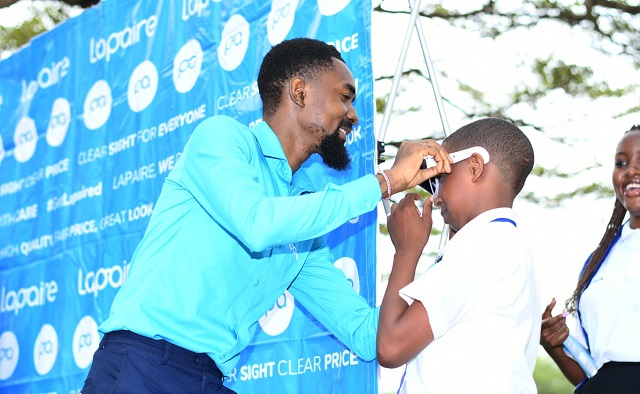
Lapaire’s fight against childhood vision problems in Africa
Kampala, Uganda | PATRICIA AKANKWATSA | Good vision is essential for children’s academic success and overall development in today’s digitally driven world. Unfortunately, millions of children across Africa suffer from undiagnosed vision problems, which can have lasting negative consequences.
According to World Health Organization (WHO) figures, one in every six blind individuals globally lives in Africa, along with 26 million others grappling with varying degrees of visual impairment.
Despite this significant burden, alarming statistics reveal that only 14% of individuals who need cataract surgery actually receive it, while more than 80% of those with myopia (short-sightedness) go untreated. In contrast, North America, Australasia, Western Europe, and the Asia-Pacific region report treatment rates below 10%.
Furthermore, only 12% of Africans in need of glasses or surgical interventions for blurred vision receive the necessary care, resulting in substantial economic costs for these nations. The global estimated cost of uncorrected refractive errors and cataracts is approximately US$14.3 billion annually.
Lapaire steps in
In response to this pressing issue, Lapaire, a leading provider of affordable eye care services in Uganda, has stepped up to address vision impairment among children through its comprehensive school-based eye health programs.
Lapaire’s campaigns aim to raise awareness about eye health directly within schools. By conducting free eye screenings and educational workshops, Lapaire seeks to identify children who require glasses or further medical attention. Early detection is crucial for preventing more severe vision problems and ensuring that children receive the support they need to thrive academically and socially.
During World Sight Day celebrations at Buddo Secondary School on October 10, Jackline Baboneraawo, an eye specialist at Lapaire Uganda, emphasized that refractive errors such as nearsightedness, farsightedness, and astigmatism are primary causes of vision problems in children.
“These conditions often go unnoticed, leading to academic struggles, developmental delays, and even social isolation. Children with vision problems may find it challenging to participate fully in classroom activities, which can result in a loss of self-confidence and decreased motivation to learn,” she explained.
Baboneraawo underscored the importance of enabling good vision in early childhood, stating that it allows children to develop normally and reach their full potential in all areas of life. “We believe that early detection and treatment can help curb future vision loss, as untreated eye health problems can lead to blindness,” she added.
Lapaire already reached out to 50,000 children
Since September 2024, Lapaire has been conducting interactive workshops in partner schools across its operating countries. These workshops are designed to educate children about the importance of eye health through engaging activities and interactive quizzes. Lapaire has already reached over 50,000 children in various schools across Uganda, Mali, Togo, Benin, Burkina Faso, and Côte d’Ivoire.
Oliver Mwanko Wambile, the Public Relations and Communication Officer at East Africa Lapaire Glasses, emphasized the crucial role schools play in promoting eye health. “Teachers are often the first to observe signs of vision problems, such as squinting, sitting too close to the board, or struggling with reading and writing,” he noted. Lapaire’s programs aim to equip teachers and parents with the knowledge to recognize these early indicators and encourage referrals for screenings.
Mwanko also highlighted that modern lifestyle factors contribute to rising eye problems among children. “With children spending excessive time on screens, it’s crucial to encourage outdoor play. A child under five spending 14 hours on a screen is not healthy. They should be outdoors for at least two hours a day to experience different scenarios and colors, as the eye muscles are still developing and need to be exercised,” he advised.
Baboneraawo urged parents to monitor their children’s eye health, emphasizing the importance of nutrition and physical activity, as conditions like pressure and diabetes can also lead to eye problems.
The WHO advocates for integrating eye screenings into routine newborn examinations, highlighting the need for standardized screening guidelines to identify potential vision issues in infants and older children. Healthcare providers at all levels must receive adequate training to effectively detect, refer, diagnose, and manage children with vision impairments.
 The Independent Uganda: You get the Truth we Pay the Price
The Independent Uganda: You get the Truth we Pay the Price



